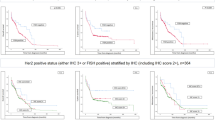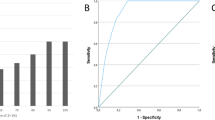Abstract
This study investigated the degree of interlaboratory agreement when HER-2/neu was evaluated by immunohistochemistry (IHC) on archival primary breast cancer samples. IHC for HER-2/neu was performed on the same archival tissue sections from 394 invasive primary breast cancers in two different laboratories. Both laboratories used the primary antibody NCL-CB11; however, different methods of immunostaining (antigen retrieval procedure and manual processing or no antigen retrieval and autostainer processing) as well as different scoring systems were used. Fluorescence in situ hybridization (FISH), considered as the correlation method for HER-2/neu status determination, was performed using the PathVysion kit and compared to the IHC results. Forty-eight of 394 analyzed tumors (12.2%) were scored as HER-2/neu positive in one laboratory, and 109 (27.7%) in the other laboratory where antigen retrieval was performed. Complete concordance in categorization of HER-2/neu status between the two laboratories was achieved in 333 of 394 cases (84.5%). FISH performed in 248 formalin-fixed samples revealed HER-2/neu gene amplification in 55/248 (22.2%). Concordance of FISH and IHC was found in 211/248 cases (85.1%) and 220/248 cases (88.7%) when the CB11 antibody was used without and with antigen retrieval, respectively. Both IHC methods generated similar rates of false results, but with different positive predictive values. Our data demonstrate that HER-2/neu evaluation by IHC is not a reproducible technique if there is no standardization of the procedure.
Similar content being viewed by others
References
Slamon DJ, Clark GM, Wong SG, Levin WJ, Ullrich A, McGuire WL: Human breast cancer: correlation of relapse and survival with amplification of the HER-2/neu oncogene. Science 235: 177–182, 1987.Interlaboratory agreement for HER-2/neu evaluation 119
Ross JS, Fletcher JA: HER-2/neu (c-erb-B2) gene and protein in breast cancer. Am J Clin Pathol 112: S53-S67, 1999
Harari D, Yarden Y: Molecular mechanisms underlying ErbB2/HER2 action in breast cancer. Oncogene 19: 6002–6114, 2000
_Yu D, Hung M-C: Overexpression of ErbB2 in cancer and ErbB2-targeting strategies. Oncogene 19: 6115–6121, 2000
Gusterson BA, Gelber RD, Goldhirsch A, Price KN, Säve-Söderborgh J, Anbazhagan R, Styles J, Rudenstam C-M, Golouh R, Martinez-Tello F, Tiltman A, Torhorst J, Grigolato P, Bettelheim R, Neville AM, Bürki K, Castiglione M, Collins J, Lindtner J, Senn JJ: Prognostic importance of c-erbB-2 expression in breast cancer. J Clin Oncol 10: 1049–1056, 1992
Toikkanen S, Helin H, Isola J, Joensuu H: Prognostic sig-nificance of HER-2 oncoprotein expression in breast cancer: a 30-year follow-up. J Clin Oncol 10: 1044–1048, 1992
Kallioniemi O-P, Holli K, Visakorpi T, Koivula T, Helin HH, Isola JJ: Association of c-erbB-2 protein over-expression with high rate of cell proliferation, increased risk of visceral meta-stasis and poor long-term survival in breast cancer. Int J Cancer 49: 650–655, 1991
Muss HB, Thor AD, Berry DA, Kute T, Liu ET, Koerner F, Cirrincione CT, Budman DR, Wood WC, Barcos M, Hender-son IC: c-erbB-2 expression and response to adjuvant therapy in women with node-positive early breast cancer. N Engl J Med 330: 1260–1266, 1994
Paik S, Bryant J, Park C, Fisher B, Tan-Chiu E, Hyams D, Fisher ER, Lippman ME, Wickerham DL, Wolmark N: erbB-2 and response to doxorubicin in patients with axil-lary lymph node-positive, hormone receptor-negative breast cancer. J Natl Cancer Inst 90: 1361–1370, 1998
Thor AD, Berry DA, Budman DR, Muss HB, Kute T, Henderson IC, Barcos M, Cirrincione C, Edgerton S, Allred C, Norton L, Liu ET: erbB-2, p53, and efficacy of adjuvant therapy in lymph node-positive breast cancer. J Natl Cancer Inst 90: 1346–1360, 1998
Järvinen TAH, Liu ET: Effects of HER-2/neu on chemo-sensitivity of tumour cells. Drug Resist Updates 3: 319–324, 2000
Pegram MD, Lipton A, Hayes DF, Weber BL, Baselga JM, Tripathy D, Baly D, Baughman SA, Twaddell T, Glaspy JA, Slamon DJ: Phase II study of receptor-enhanced chemosensi-tivity using recombinant humanized anti-p185 HER-2/neu monoclonal antibody plus cisplatin in patients with HER-2/ neu overexpressing metastatic breast cancer refractory to chemotherapy treatment. J Clin Oncol 16: 2659–2671, 1998
Cobleigh MA, Vogel CL, Tripathy D, Robert NJ, Scholl S, Fehrenbacher L, Wolter JM, Paton V, Shak S, Lieberman G, Slamon DJ: Multinational study of the efficacy and safety of humanized anti-HER-2 monoclonal antibody in women who have HER-2 overexpressing metastatic breast cancer that has progressed after chemotherapy for metastatic disease. J Clin Oncol 17: 2639–2648, 1999
Pegram MD, Slamon DJ: Combination therapy with tratuzu-mab (Herceptin) and cisplatin for chemoresistant metastatic breast cancer: evidence for receptor-enhanced chemosensiti-vity. Semin Oncol 26: 89–95, 1999
Pegram M, Hsu S, Lewis G, Pietras R, Beryt M, Sliwkowski M, Coombs D, Baly D, Kabbinavar F, Slamon D: Inhibitory effects of combinations of HER-2/neu antibody and chemo-therapeutic agents used for treatment of human breast cancers. Oncogene 18: 2241–2251, 1999
Shak S: Overview of the trastuzumab (Herceptin) anti-HER-2 monoclonal antibody clinical program in HER-2-overexpressing metastatic breast cancer. Semin Oncol 26: 71–77, 1999
Mitchell MS, Press MF: Therole of immunohistochemistry and fluorescence in situ hybridization for HER-2/neu in as-sessing the prognosis of breast cancer. Semin Oncol26: 108–116, 1999
Dowsett M, Cooke T, Ellis I, Gullick WJ, Gusterson B, Mallon E, Walker R: Assessment of HER-2 status in breast cancer: why, when and how? Eur J Cancer 36: 170–176, 2000
Kallioniemi OP, Kallioniemi A, Kurisu W, Thor A, Chen L-C, Smith HS, Waldman FM, Pinkel D, Gray JW: ERBB2 amplification in breast cancer analyzed by fluorescence in situ hybridization. Proc Natl Acad Sci USA 89: 5321–5325, 1992
Pauletti G, Godolphin W, Press MF, Slamon DJ: Detection and quantitation of HER-2/neu gene amplification in hu-man breast cancer archival material using fluorescence in situ hybridization. Oncogene 13: 63–72, 1996
Hoang MP, Sahin AA, Ordonez NG, Sneige N: HER-2/neu amplification compared with HER-2/neu protein overexpres-sion and interobserver reproducibility in invasive breast car-cinoma. Am J Clin Pathol 113: 852–859, 2000
Jimenez RE, Wallis T, Tabasczka P, Visscher DW: Deter-mination of HER-2/neu status in breast carcinoma: compar-ative analysis of immunohistochemistry and fluorescent in situ hybridization. Mod Pathol 13: 37–45, 2000
Jacobs TW, Gown AM, Yaziji H, Barnes MJ, Schnitt SJ: Comparison of fluorescence in situ hybridization and immuno-histochemistry for the evaluation of HER-2/neu in breast cancer. J Clin Oncol 17: 1974–1982, 1999
Bankfalvi A, Simon B, Brandt B, Bürger H, Vollmer I, Dockhorn-Dworniczack B, Lellé R-J, Boecker W: Compar-ative methodological analysis of erbB-2/HER-2 gene dosage, chromosomal copy number and protein overexpression in breast carcinoma tissues for diagnostic use. Histopathology 37: 411–419, 2000
Ridolfi RL, Jamehdor MR, Arber JM: HER-2/neu testing in breast carcinoma: a combined immunohistochemical and fluorescence in situ hybridization approach. Mod Pathol 13: 866–873, 2000
Jacobs TW, Gown AM, Yaziji H, Barnes MJ, Schnitt SJ: HER-2/neu protein expression in breast cancer evaluated by immunohistochemistry. A study of interlaboratory agreement. Am J Clin Pathol 113: 251–258, 2000
Pauletti G, Dandekar S, Rong H, Ramos L, Peng HJ, Seshadri R, Slamon DJ: Assessment of methods for tissue-based detection of the HER-2/neu alteration in human breast cancer: a direct comparison of fluorescence in situ hybridiza-tion and immunohistochemistry. J Clin Oncol 18: 3651–3664, 2000
Wang S, Saaborian MH, Frenkel E, Hynan L, Gokaslan ST, Ashfaq R: Laboratory assessment of the status of HER-2/neu protein and oncogene in breast cancer specimens: compar-ison in immunohistochemistry assay with fluorescence in situ hybridization assays. J Clin Pathol 53: 374–381, 2000
Couturier J, Vincent-Salomon A, Nicolas A, Beuzeboc P, Mouret E, Zafrani B, Sastre-Garau X: Strong correlation between results of fluorescent in situ hybridization and im-munohistochemistry for the assessment of ERBB2 (HER-2/ neu) gene status in breast carcinoma. Mod Pathol 13: 1238–1243, 2000
Press MJ, Hung G, Godolphin W, Slamon DJ: Sensitivity of HER-2/neu antibodies in archival tissue samples: potential source of error in immunohistochemical studies of oncogene expression. Cancer Res 54: 2771–2777, 1994.
Jacobs TW, Gown AM, Yaziji H, Barnes M, Schnitt SJ: Specificity of HercepTest in determinig HER-2/neu status of breast cancers using the US FDA-approved scoring system. J Clin Oncol 17: 1983–1987, 1999
Vang R, Cooley LD, Harrison WR, Reese T, Abrams J: Im-munohistochemical determination of HER-2/neu expression in invasive breast carcinoma. Am J Clin Pathol 113: 669–674, 2000
Kay EW, Barry Walsh CJ, Cassidy M, Curran B, Leader M: C-erbB-2 immunostaining: problems with interpretation. J Clin Pathol 47: 816–822, 1994
Di Leo A, Larsimont D, Beauduin M, Vindevoghel A, Michel J, Focan C, Tagnon A, Ries F, Gobert P, Closon-Dejardin MT, Dolci S, Bartholomeus S, Lobelle JP, Paesmans M, Piccart MJ: CMF or anthracycline-based adjuvant chemother-apy for node-positive breast cancer patients: 4 year results of a Belgian randomised clinical trial with predictive markers analysis. Proc AmSoc Clin Oncol 18: p. 69a (Abstr 258), 1999
Järvinen TAH, Holli K, Kuukasjärvi T, Isola J: Predictive value of topo-isomerase II alpha and other prognostic factors for epirubicin chemotherapy in advanced breast cancer. Br J Cancer 77: 2267–2273, 1998
Isola J, Chu L, DeVries S, Matsamura K, Chew K, Ljung BM, Waldman FM: Genetic alterations in ErbB-2 amplified breast carcinomas. Clin Cancer Res 5: 4140–4145, 1999
Järvinen TAH, Tanner M, Rantanen V, Barlund M, Borg A, Grenman S, Isola JJ: Amplification and deletion of topoi-somerase IIa gene are common in ErbB-2 amplified breast cancer and alter the sensitivity to doxorubicin. Am J Pathol 156: 839–847, 2000
Gancberg D, Lespagnard L, Rouas G, Paesmans M, Piccart M, Di Leo A, Nogaret JM, Hertens D, Verhest A, Larsimont D: Sensitivity of HER-2/neu antibodies in archival tissue samples of invasive breast carcinomas. Correlation with oncogene amplification in 160 cases. Am J Clin Pathol 113: 675–682, 2000
United States Food and Drug Administration: Department of health and human services: oncology drugs advisory com-mittee-58th Meeting, September 2, 1998, P.M. Session. Http://www.fda.gov/ohrms/dockets/ac/98/transcrpt/3443t2.rtf
Roche PC, Ingle JN: Increased HER-2 with U.S. Food and Drug Administration-approved antibody (letter). J Clin Oncol 17: 434, 1999
Von Wasielewski R, Werner M, Nolte M, Wilkens L, Georgii A: Effects of antigen retrieval by microwave heating in formalin-fixed tissue sections on a broad panel of antibodies. Histochem 102: 165–172, 1994
Shi SR, Key ME, Kalra KL: Antigen retrieval in formalin-fixed, paraffin-embedded tissues: an enhancement method for immunohistochemical staining based on microwave oven heating of tissue sections. J Histochem Cytochem 39: 741–748, 1991
Mass RD, Sanders C, Charlene K, Johnson L, Everett T, Anderson S: The concordance between the clinical trial assay (CTA) and fluorescence in situ hybridization (FISH) in the Herceptin pivotal trials. Proc Am Soc Clin Oncol 19: p.75a (Abstr 291), 2000
Author information
Authors and Affiliations
Rights and permissions
About this article
Cite this article
Gancberg, D., Järvinen, T., Leo, A.d. et al. Evaluation of HER-2/NEU Protein Expression in Breast Cancer by Immunohistochemistry: An Interlaboratory Study Assessing the Reproducibility of HER-2/NEU Testing. Breast Cancer Res Treat 74, 113–120 (2002). https://doi.org/10.1023/A:1016146130767
Issue Date:
DOI: https://doi.org/10.1023/A:1016146130767




